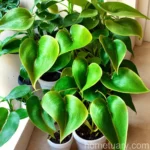Pothos (Epipremnum aureum ‘Neon’) – The Ultimate Care Guide
As a plant scientist, one of the most fascinating and popular plants that I have had the pleasure to study is the Pothos, scientifically known as Epipremnum aureum ‘Neon’. This vibrant and hardy plant is popular for its elegant, trailing vines and beautiful neon-colored leaves. In this comprehensive guide, we will delve into the rich world of Pothos, covering its culture, uses, care tips, and much more. Whether you are a beginner or a seasoned plant enthusiast, this guide will equip you with the knowledge to nurture and enjoy the beauty of the Pothos plant.
What is Pothos (Epipremnum aureum ‘Neon’)?
Pothos, commonly known as Devil’s Ivy, is a species of flowering plant in the arum family, Araceae. It is native to the Solomon Islands, but is also cultivated worldwide as a popular houseplant. The ‘Neon’ variety is cherished for its vibrant, heart-shaped leaves that feature a stunning neon green color. This plant is an evergreen vine that can grow to impressive lengths, making it a perfect choice for hanging baskets, as well as for trailing down from shelves and elevated surfaces.
Key Takeaways – Pothos (Epipremnum aureum ‘Neon’)
The Pothos plant, particularly the ‘Neon’ variety, offers a wide array of benefits and features that make it a popular choice among plant enthusiasts. Here are some of the key takeaways about this fascinating plant:
- Easy to Grow: Pothos is an exceptionally easy plant to grow, making it ideal for beginners and experienced gardeners alike.
- Air Purifying: It is known for its air-purifying qualities, helping to enhance indoor air quality.
- Low Maintenance: Requires minimal care, making it suitable for busy individuals.
- Versatile: Can thrive in various light conditions and can be grown in soil or water.
- Decorative: The attractive, trailing habit of the Pothos plant makes it a beautiful addition to any indoor space.
Now, let’s explore the various aspects of Pothos care, from its culture and uses to specific care guidelines.
Culture
Uses
Pothos (Epipremnum aureum ‘Neon’) is a versatile plant that offers a range of uses, both aesthetic and practical. Some common uses of this plant include:
- Indoor Decoration: Pothos is often used as a decorative plant in homes, offices, and public spaces due to its attractive foliage and trailing growth habit.
- Air Purification: The plant is renowned for its ability to purify indoor air by removing toxins and enhancing air quality.
- Hanging Baskets: The trailing vines of Pothos make it an ideal choice for hanging baskets, adding an elegant touch to indoor spaces.
- Terrariums and Vertical Gardens: Pothos is commonly used in terrariums and vertical gardens, where its lush foliage adds a refreshing, natural element to the environment.
Water
Pothos plants are fairly adaptable when it comes to watering. They prefer to dry out between waterings, as they are more tolerant of underwatering than overwatering. However, it is important to maintain an appropriate watering schedule to ensure the plant’s health and vitality.
- Watering Schedule: Water the Pothos plant when the top inch of the soil feels dry to the touch. Allow excess water to drain from the bottom of the pot to prevent waterlogging.
- Water Requirements: The plant prefers moderately moist soil but can tolerate short periods of drought. Adjust the watering frequency based on the environmental conditions and the moisture level of the soil.
Sunlight
Pothos plants exhibit considerable flexibility when it comes to light conditions, making them suitable for various indoor environments. Understanding the plant’s light requirements is crucial for ensuring optimal growth and foliage development.
- Light Requirements: Pothos thrives in bright, indirect light. However, it can also tolerate low light conditions, making it an excellent choice for spaces with limited natural light.
- Light Exposure: Avoid exposing the plant to direct sunlight, as this can lead to leaf scorching and damage. Indirect sunlight or artificial light sources are preferred for optimal growth.
Fertilizer
Proper fertilization is essential for promoting healthy growth and vibrant foliage in Pothos plants. While these plants are relatively low-maintenance, providing suitable nutrients can significantly enhance their appearance and overall condition.
- Fertilizing Frequency: Feed the Pothos plant with a balanced, water-soluble fertilizer once a month during the growing season (spring and summer). Avoid fertilizing during the dormant winter period.
- Fertilizer Type: Choose a general-purpose houseplant fertilizer with an NPK ratio of 20-20-20 or a similar balanced formulation. Dilute the fertilizer according to the manufacturer’s instructions before application.
Soil
The choice of soil plays a crucial role in the health and vigor of Pothos plants. A well-draining and nutrient-rich potting mix is essential for providing an optimal growing environment for these plants.
- Potting Mix: Use a high-quality, well-draining potting mix that provides adequate aeration and moisture retention. A combination of peat moss, perlite, and compost is well-suited for Pothos plants.
- Soil pH: Pothos plants prefer a slightly acidic to neutral soil pH range of 6.1 to 7.3. Avoid using heavy or compacted soils that can hinder drainage and root development.
Pruning
Regular pruning is beneficial for maintaining the shape, density, and overall health of Pothos plants. Pruning also helps to control the growth and prevent the plant from becoming overly leggy or unruly.
- Pruning Frequency: Trim the leafy vines and stems as needed to control the plant’s size and shape. Remove any yellowing or damaged leaves to encourage new growth.
- Propagation: The pruned cuttings can be used for propagation, allowing you to expand your Pothos collection or share the plant with others.
Propagation
Pothos plants can be easily propagated through stem cuttings, making it a rewarding and cost-effective way to multiply your plant collection or share the beauty of Pothos with friends and family.
- Propagation Methods: Propagate Pothos through stem cuttings by taking 4- to 6-inch sections of healthy vines with at least two nodes. Place the cuttings in water or directly into moist potting soil to encourage root development.
- Rooting Time: Depending on the propagation method, Pothos cuttings typically root within a few weeks and can be transplanted into individual pots once a healthy root system has developed.
Container Popularity
The popularity of Pothos in containers stems from its adaptability and aesthetic appeal when grown indoors. Choosing the right container size and type is essential for promoting healthy growth and preventing root congestion.
- Container Size: Select a container that provides ample room for the plant’s roots to spread comfortably. A 6- to 8-inch pot is generally suitable for young Pothos plants, while larger, more established plants may require 10- to 12-inch pots.
- Drainage: Ensure that the chosen container has drainage holes to allow excess water to escape, preventing waterlogging and root rot.
Common Diseases
While Pothos plants are relatively resistant to diseases, they may occasionally encounter issues such as root rot, leaf spot, or stem rot. Understanding common plant diseases and their causes is important for implementing effective prevention and treatment strategies.
Disease Diagnosis
- Root Rot: Excessive soil moisture, poor drainage, or overwatering can lead to root rot in Pothos plants. Symptoms include wilting, yellowing leaves, and a foul odor emanating from the soil.
- Leaf Spot: Fungal pathogens can cause circular, discolored spots on the leaves of Pothos plants. Proper air circulation and watering practices can help prevent leaf spot diseases.
- Stem Rot: This disease is often caused by overwatering and poorly aerated soil, leading to the rotting of the plant’s stems at the soil line.
Common Pests
Pothos plants are relatively resistant to pests, but they may occasionally attract common houseplant pests such as mealybugs, spider mites, and aphids. Vigilance and prompt action are crucial for controlling and preventing pest infestations.
- Mealybugs: These small, white, cottony pests can infest the foliage and stems of Pothos plants, leading to stunted growth and yellowing leaves.
- Spider Mites: These tiny arachnids can cause stippling and webbing on the leaves, affecting the plant’s overall appearance and vitality.
- Aphids: Aphids may gather on the tender new growth of Pothos plants, sucking sap from the leaves and causing distortion.
Botanist’s Tips
As a botanist, I have accumulated several tips for caring for Pothos (Epipremnum aureum ‘Neon’) based on my extensive experience with this plant. These insights can help you achieve success in cultivating and enjoying the beauty of Pothos in your home or indoor space.
- Regular Inspection: Conduct regular inspections of your Pothos plants to identify and address any signs of pest infestation, disease, or nutrient deficiencies.
- Optimal Watering: Strive to maintain a consistent watering schedule, allowing the top inch of the soil to dry out between waterings to prevent overwatering.
- Promote Trailing Growth: To encourage lush, trailing growth, consider placing the Pothos plant on a high shelf or in a hanging basket where its vines can cascade gracefully.
- Pruning Technique: Use clean, sharp scissors or pruning shears to make precise cuts when pruning Pothos plants, ensuring that the wounds heal quickly and reduce the risk of disease transmission.
- Rotate the Plant: Occasionally rotate the Pothos plant to promote even growth and prevent it from leaning excessively toward a light source.
Fun Facts
To add a bit of flair to our exploration of Pothos, here are some intriguing and fun facts about this remarkable plant:
- Pothos plants are considered to be among the most effective air-purifying houseplants, helping to remove common indoor pollutants such as formaldehyde, benzene, and xylene.
- The leaves of Pothos are distinct in their variegated colors, with the ‘Neon’ variety captivating observers with its vibrant neon green foliage.
- In addition to being an excellent indoor plant, Pothos can also be cultivated outdoors in tropical and subtropical regions, where it thrives in shaded or partially shaded areas.
- Pothos is a great choice for pet owners, as the plant is listed as non-toxic to cats and dogs by the American Society for the Prevention of Cruelty to Animals (ASPCA).
Links to External Resources
For further exploration of Pothos care and cultivation, consider the following external resources:
- Pothos Care Tips from The Spruce: A comprehensive guide to caring for Pothos plants, offering insights into watering, light requirements, and propagation methods.
- Epipremnum aureum ‘Neon’ Facts from Costa Farms: Learn about the unique characteristics of the ‘Neon’ variety of Pothos and how to integrate it into your indoor spaces.
- Indoor Gardening with Pothos from Gardening Know How: Explore the benefits of growing Pothos indoors and gain valuable tips for maintaining and enjoying these beautiful plants.
In conclusion, Pothos (Epipremnum aureum ‘Neon’) is a remarkable plant that offers a wealth of benefits, from its air-purifying qualities to its captivating foliage and low-maintenance care requirements. Whether you are looking to add a touch of greenery to your home or seeking a resilient and versatile houseplant, the Pothos plant is an excellent choice that is sure to bring joy and natural beauty to your indoor spaces. With the knowledge and insights shared in this comprehensive guide, you are well-equipped to embark on a successful journey of nurturing and appreciating the unique charm of the Pothos plant.
Thank you for joining me on this enlightening exploration of Pothos care and cultivation. Happy gardening!















